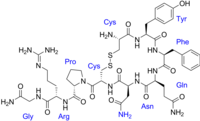
Neurospora casein kinase 1a recruits the circadian clock protein FRQ via the C‐terminal lobe of its kinase domain
Sign Up to like & getrecommendations! Published in 2022 at "FEBS Letters"
DOI: 10.1002/1873-3468.14435
Abstract: Timing by the circadian clock of Neurospora is associated with hyperphosphorylation of frequency (FRQ), which depends on anchoring casein kinase 1a (CK1a) to FRQ. It is not known how CK1a is anchored so that approximately… read more here.
Keywords: circadian clock; neurospora casein; frq; kinase ... See more keywords

Circadian clock regulation via biomaterials for nucleus pulposus.
Sign Up to like & getrecommendations! Published in 2023 at "Advanced materials"
DOI: 10.1002/adma.202301037
Abstract: Circadian clock disorder during tissue degeneration has been considered the potential pathogenesis for various chronic diseases, such as intervertebral disc degeneration (IVDD). In this study, circadian clock-regulating biomaterials (ClockMPs) that could effectively activate the intrinsic… read more here.
Keywords: circadian clock; clockmps could; clock regulation; nucleus pulposus ... See more keywords

3D‐atlas of the brain of the cockroach Rhyparobia maderae
Sign Up to like & getrecommendations! Published in 2022 at "Journal of Comparative Neurology"
DOI: 10.1002/cne.25396
Abstract: The Madeira cockroach Rhyparobia maderae is a nocturnal insect and a prominent model organism for the study of circadian rhythms. Its master circadian clock, controlling circadian locomotor activity and sleep–wake cycles, is located in the… read more here.
Keywords: cockroach; circadian clock; rhyparobia maderae; brain ... See more keywords

Circadian Rhythm Effects on the Molecular Regulation of Physiological Systems.
Sign Up to like & getrecommendations! Published in 2021 at "Comprehensive Physiology"
DOI: 10.1002/cphy.c210011
Abstract: Nearly every system within the body contains an intrinsic cellular circadian clock. The circadian clock contributes to the regulation of a variety of homeostatic processes in mammals through the regulation of gene expression. Circadian disruption… read more here.
Keywords: molecular regulation; physiological systems; circadian rhythm; circadian clock ... See more keywords

Circadian clock gene BMAL1 controls testosterone production by regulating steroidogenesis‐related gene transcription in goat Leydig cells
Sign Up to like & getrecommendations! Published in 2021 at "Journal of Cellular Physiology"
DOI: 10.1002/jcp.30334
Abstract: Testosterone is produced by Leydig cells (LCs) and undergoes diurnal changes in serum levels in rats, mice, and humans, but little is known in goats. The present study revealed that goat serum testosterone levels displayed… read more here.
Keywords: bmal1; circadian clock; testosterone production; goat lcs ... See more keywords

Expression of circadian clock genes in leukocytes of patients with Meniere's disease
Sign Up to like & getrecommendations! Published in 2022 at "Laryngoscope Investigative Otolaryngology"
DOI: 10.1002/lio2.757
Abstract: The underlying etiology of Meniere's disease (MD) is not completely clear, but the precipitated triggers may alter the circadian clock in patients with MD. This study aims to survey the expression of circadian clock genes… read more here.
Keywords: circadian clock; expression circadian; leukocytes patients; meniere disease ... See more keywords

Using Tandem Affinity Purification to Identify Circadian Clock Protein Complexes from Arabidopsis.
Sign Up to like & getrecommendations! Published in 2022 at "Methods in molecular biology"
DOI: 10.1007/978-1-0716-1912-4_15
Abstract: Identification of protein-protein interactions is an effective method of elucidating new roles for circadian clock-associated proteins that can expand beyond the information collected from transcriptional studies and genetic screens. Tandem affinity purification coupled with liquid… read more here.
Keywords: protein; tandem affinity; circadian clock; affinity purification ... See more keywords

High Spatial Resolution Luciferase Imaging of the Arabidopsis thaliana Circadian Clock.
Sign Up to like & getrecommendations! Published in 2022 at "Methods in molecular biology"
DOI: 10.1007/978-1-0716-1912-4_4
Abstract: The A. thaliana circadian clock is an example of a gene network that generates rich temporal and spatial dynamics. Bioluminescent imaging has proven a powerful method to help dissect the genetic mechanisms that generate oscillations… read more here.
Keywords: resolution; thaliana circadian; luciferase imaging; circadian clock ... See more keywords

How to Detect QTLs in the Plant Circadian Clock.
Sign Up to like & getrecommendations! Published in 2022 at "Methods in molecular biology"
DOI: 10.1007/978-1-0716-1912-4_8
Abstract: One of the most powerful methods to identify loci controlling complex quantitative traits has been the quantitative trait locus (QTL) mapping. The QTL mapping approach has proven immensely useful to improve our understanding of key… read more here.
Keywords: qtl mapping; circadian clock; detect qtls; qtls plant ... See more keywords

Measuring Hypocotyl Length in Arabidopsis.
Sign Up to like & getrecommendations! Published in 2022 at "Methods in molecular biology"
DOI: 10.1007/978-1-0716-1912-4_9
Abstract: Circadian clocks allow organisms to synchronize growth to occur at the most optimal time of the day. In plants, the circadian clock controls the timing of hypocotyl (seedling stem) elongation. The activity of the circadian… read more here.
Keywords: hypocotyl elongation; hypocotyl length; elongation; circadian clock ... See more keywords

Central Circadian Clock Regulates Energy Metabolism.
Sign Up to like & getrecommendations! Published in 2018 at "Advances in experimental medicine and biology"
DOI: 10.1007/978-981-13-1286-1_5
Abstract: Our body not only responds to environmental changes but also anticipates them. The light and dark cycle with the period of about 24 h is a recurring environmental change that determines the diurnal variation in… read more here.
Keywords: energy metabolism; clock; central circadian; circadian clock ... See more keywords